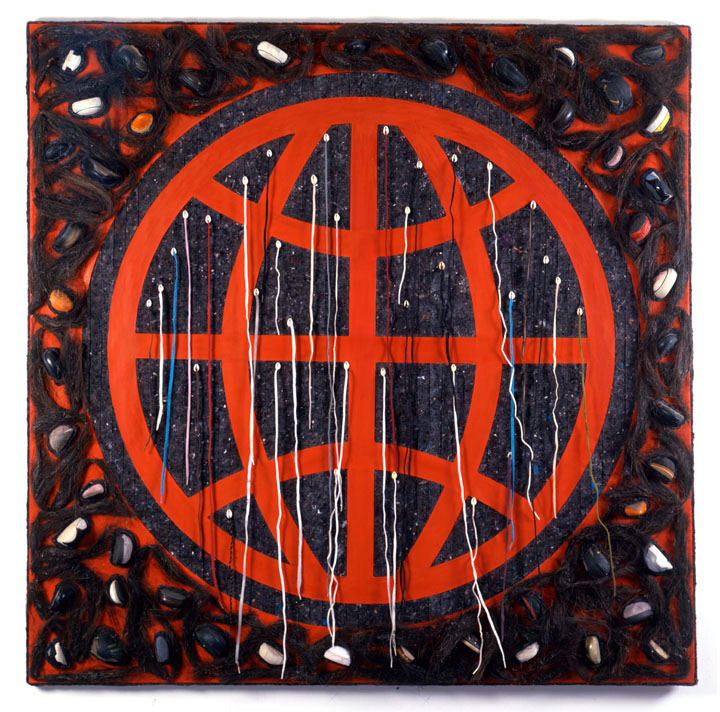Now that the progressing phases of #Kony2012 (endorsement, backlash,
Kony has been the way in for millions, let him be the way out. His peripatetic habits — traversing northern Uganda, the Democratic Republic of Congo, the Central African Republic, and back — present a moving point from which to track the stunning death-making and rent extraction that occurred there over the past two decades. It's a massive total to which Kony contributed almost nothing in the grand scheme of things. Four million people died from conflict in the DRC during the 1990s and early 2000s, and there were no media campaigns to "raise awareness" about them. This death-making is tied to resource extraction in what we might call the necroeconomics at play on the ground in many of the spaces where Kony and other militias have trod.
If successful, the #Kony2012 campaign might actually buttress this death-making because it relies fundamentally on the legitimacy and ability of the United States military to patrol and control Africa and works to provide symbolic and discursive cover for the creeping penetration of the U.S. military’s AFRICOM across the continent. In the spirit, then, of raising awareness, we might train our eyes on the AFRICOM project: What are its goals? What are the legacies of U.S. military involvement in Africa? What is the relationship between AFRICOM and these economies of death?
I Drink Your Milkshake: Extraction Around Kony’s Travels
Despite what Invisible Children might have you believe, Joseph Kony is not the only “bad guy” in sub-Saharan Africa’s story of militias and armies abusing citizens. Throughout the two-decade-long war and the Ugandan Army's (UPDF) attempts to hunt down Kony and the Lord's Resistance Army (LRA), the UPDF has repeatedly terrorized communities they were meant to protect. Just last week Uganda newspapers reported that the UPDF was raping and looting in its Obama-enabled search for Kony,
But the UPDF is more than just a brutal sheriff's posse. As William Reno documents in a fascinating study, Ugandan (and Rwandan) armies used the pretense of security threats from armed militias such as Kony’s LRA for years to establish their own extraction rackets in the provinces of southern and eastern DRC where state control is still mostly absent.
Uganda’s President Museveni, after attaining power in a 1986 coup, solved the peacetime problem of a glut of unskilled and jobless former soldiers by exporting them to the DRC to find “jobs” for themselves. By deploying improvisational extra-territorial tactics, the Ugandan military essentially became a military business, repatriating millions of dollars’ worth of gold, diamonds, and timber to the home country for export, a process which generated foreign exchange and balance of payments improvement.

The state had to somehow both use this machine of death-and-rent-making and also keep it safely at arm’s length in a sort of orbit. It couldn’t be allowed to spin off too far and become autonomous (because then it would not repatriate anything, and might instead set up its own fully integrated extraction regime), but it also had to be kept at a distance to prevent it from devouring its master.
Reno adds that the IMF, needing to tout Uganda as the poster child for reform facilitated by neoliberal structural-adjustment programs, obscured the source of the country’s so-called growth:
Profit from warfare is clandestine in the sense that creditors and donors publicly condemn it, but formal in the sense that its proceeds can appear in official statistics as evidence of economic development and deregulation that these same outsiders use to legitimate their decisions…. Creditors in turn claim Uganda as a seemingly successful HIPC client that can be used to set a higher performance standard for other countries included in this programme. "If Uganda can do it, no other government has an excuse," said an official in reference to Uganda's achievement of fiscal benchmarks prior to its HIPC approval.
Death-Making / Rent Extracting: Necroeconomics
What we observe here may be conceived as a cousin to Achille Mbembe’s necropolitics, the power over life and death guaranteed by excessive physical and social violence. This is necroeconomics, the circulation and exchange of substances that are wrested from the earth to the point of absolute exhaustion, a process protected by a regime of necropower. This mode of extraction extinguishes, subverts, drains, and makes dead various bodies, ecologies, relationships, and spaces for the purpose of squeezing out natural resources that then feed into broader supply chains. The ability to execute this task efficiently is directly tied to the ability to execute efficient death-making. As Mbembe writes,
Coercion itself has become a market commodity. Military manpower is bought and sold on a market in which the identity of suppliers and purchasers means almost nothing. Urban militias, private armies, armies of regional lords, private security firms, and state armies all claim the right to exercise violence or to kill. Neighboring states or rebel movements lease armies to poor states. Nonstate deployers of violence supply two critical coercive resources: labor and minerals. Increasingly, the vast majority of armies are composed of citizen soldiers, child soldiers, mercenaries, and privateers.

There is an inextricable relationship between the ability to make die and the ability to exhaust the land. Whereas violence lurks behind the liberal state as well, it functions best when the violence is shrouded, hidden, normalized, or at the very least projected outward at the underdeveloped and subcivilized spaces that must be pacified for exploitation. In necroeconomies, the improvisational and excessive violence is proportionate to the profits.
Mbembe, citing Elias Canetti and implicitly challenging the reductionist narratives of victimization ascribed to Africans, argues that “the lowest form of survival is killing ... Even more radically, in the logic of survival one’s horror at the sight of death turns into satisfaction that it is someone else who is dead.” The extractor in the necroeconomy behaves like this survivor figure. And by taking the material out of the ground, material — like life — that will expire if another takes it first, the extractor generates a supplement that goes beyond satisfaction to jouissance, tapping into a libidinal drive that runs beneath the instrumental desire for resource accumulation.
This suggests why a surfeit of sexual violence attends these spaces. The only aspect of the Congo extraction wars highlighted in Western media has been the staggering number of rapes of women caught in the buzzsaw, attention that is charged with the prurient desire to observe the proverbial child being abused.
The same extractive jouissance is visible "closer to home" in the gold-rush moments of Wall Street's recent hyperextraction period. There was a ravenous thrill to the boom, a palpable sense of excess and transgression effected by the ratcheting up of leverage, of more risk-taking, of opaque products known to neither buyer or seller, of perverse incentives built into the system. During this necrosis of the U.S. economy — turning something that was ostensibly meant to produce, innovate, and synthesize into a giant asset-stripping machine — is it surprising that the excesses of the industry at that moment (the millions spent on sex workers and cocaine) mirror the jouissance of the stealing itself?
While bankers are remunerated well,
As World Bank economist Lant Pritchett argues in “Boom Towns, Ghost Countries,” these zones are often left as zombified wastelands after their resources are drained, while those unlucky enough to be born there as citizens are stuck inside nation-state borders. One reason for this evacuation unto death is that while countries constituted largely by the necroeconomy can theoretically foster productive investment (Botswana stands as a positive deviant in this regard), political processes become sites for zero-sum contests for control of rents. There’s even empirical evidence that the disease in the necroeconomy can under some circumstances infect the rest of the space as well.
This system functions for those in Northern enclave economies and for comprador elites. Is it too conspiratorial to suggest that a double-barrel approach of international legal mechanisms (the ICC, the UNSC) and outright coercive force (U.S. military) are deployed to maintain that end, especially as the Chinese bogeyman emerges to threaten the balance of power in the North? This is not to say that the U.S. pulls the strings of everything that goes on in Africa (after all, the global economic architecture does most of the work of channeling resources), but it is worth questioning what AFRICOM is doing with a base in Djibouti, an antiterrorism program functioning across nine Sahelian countries, a fake-news program called “Operation Objective Voice,” and now 100 soldiers running around central Africa ostensibly to find one man named Kony.
AFRICOM’s Spectral and Creeping Presence
A brief history of the U.S. security institutions in Africa shows that conspiracies like these, seemingly the stuff of a Steven Soderbergh movie, are often quite real. In November 2011, at the annual African Studies Association conference in D.C., Michigan State professor David Wiley gave a blistering 45-minute excoriation of the U.S. military’s involvement in the continent, outlining DoD’s long legacy of antidemocratic and despicable interventions. The content of that talk is not online, but the Association of Concerned Africa Scholars, of which Wiley is a member, does have a 1997 document posted: The Case Against DOD and CIA Involvement in Funding the Study of Africa is worth quoting at length:
This resistance [of Africanist academics] to linkages with and funding from U.S. intelligence agencies and the Pentagon has been so strong because of the long history of Western interventions, the supporting of repressive rulers, and the ventures against legitimate and elected leaders in Africa. For more than 30 years, U.S. military and intelligence agencies have:
- Provided both direct and covert support to colonial and settler regimes —including the white-minority regime in Southern Rhodesia; the Portuguese colonial regimes in Angola, Mozambique, and Guinea Bissau; and the apartheid regime in South Africa.
- Subverted progressive leaders and their governments and national liberation movements — including Patrice Lumumba in the Congo, Kwame Nkrumah in Ghana, and Nelson Mandela and the ANC in the apartheid era.
- With other Western intelligence agencies, installed and/or supported dictators such as General Mobutu in Zaire, Idi Amin in Uganda, Nimeiry in Sudan, and Siad Barre in Somalia.
- Fomented civil war and conflicts through direct or indirect covert support for 'contra' factions such as UNITA in Angola and Renamo in Mozambique.
Even if one has heard tallies such as these before, reading them again reopens the wound. Amin, Rhodesia, Mobutu, apartheid South Africa, UNITA — the names crash down like hammers on an anvil. And so, why? Take U.S. support for the assassination of Congo’s Patrice Lumumba. Why? Turner cites the CIA report that labels Lumumba a classic communist but declares it nothing less than “absurd.” He goes on: “Lumumba was no communist and the Soviet Union lacked the capability to intervene in Congo.” And while there is more motivating the U.S. in its violent displacement of progressive African leaders than simply cynical attempts to capture resources,
When the Cold War ended, the U.S. military machine briefly retracted its claws. But in a sick historical twist, this left the U.S. former patron states bankrupt, and so the same citizens who were terrorized by U.S.-supported despots had to succumb to the IMF structural-adjustment programs to pay back the debt that had funded the bullets those despots used to shoot their parents. This eradication of the state, led by the Washington consensus
Fiscal policy discipline;
Redirection of public spending;
Tax reform;
Interest rates dictated by market forces;
Competitive exchange rates;
Trade liberalization;
Liberalization of inward foreign direct investment;
Privatization of state enterprises;
Deregulation;
Legal security for property rights.
After the Islamic Courts Union established the first relatively stable governing structure in fractured Somalia since 1990, [AFRICOM] provided military and intelligence support for the December 2006 Ethiopian military invasion of Somalia to over throw the Islamic Courts Union, which the U.S. suspected might be friendly to al-Qaeda. The Ethiopian invasion utterly devastated the country, sparking a humanitarian disaster identified by Refugees International as the worst in the world. Over 60 percent of the population of Mogadishu was displaced by the fighting.
And this violence is often to recapture and rechannel the necroeonomies to America’s benefit. If the controversial Jeremy Keenan is even partially correct in his description of the fabrication of terror plots by Algerian intelligence and the CIA to justify expansion of AFRICOM to secure oil resources, it is a stunning revelation. He argues in a recent Anthropology Today article that the 2001 "Cheney Report" that "singled out sub-Saharan Africa as the key source for future oil supplies" was the motivation for the U.S. to collaborate with the Algerian DRS to fabricate terror incidents to "create the ideological conditions for Washington’s militarization of Africa." Stories like these beg the question of the plots that go undiscovered, and AFRICOM is easily spectral enough to raise those suspicions.
But warfare is a secondary option, lawfare may be an even more potent tool. Mahmood Mamdani identifies the International Criminal Court as the legitimating apparatus for more interventions in Africa, given that it works selectively, not in "the interest of creating the rule of law." Instead law is weaponized, directed at states which do not accommodate U.S. interests, or at nonstate actors who threaten the often-authoritarian U.S. allies
#Kony 2012 supports both U.S.-led warfare and lawfare, and acts as a third member in the unholy trinity: the belligerent humanitarian. The long iconic photo of the Invisible Children boys toting guns as SPLA soldiers look on bemusedly underscores the lusty machismo central to the way they imagine 'solving' 'Africa'. Many of these so-called humanitarians are inseparable from those trained to kill in that they share not only the same desired ends but methods for reaching them as well. Invisible Children’s Manichean presentation of Kony makes the U.S. military the savior by default.
Beyond the Exception
It is the campaign's insistence on the exceptional nature of Kony's crimes that produce both Kony and his victims as Outside, exceptional to our everyday. Indeed, as political philosopher Sayres Rudy pointed out to me, anti-Kony and knee-jerk anti-anti-Kony may "contribute to a broader pattern of accepting the systemic instrumentalization and massacre of innocents, by rendering Kony/Invisible Children as exceptional instead of typical, allowing their offenses to constitute similar systemic actions as normal, legitimate, or
unconfirmed early report. We apologize for the error.
If the discussion around #Kony2012 stops without exploring these connections, we are left not with politics but with elite-liberal mutual masturbation over the way to address the exceptional rather than the systemic. Going beyond this script requires laying bare the maneuverings of the U.S. military and also the system of global economic extraction and transfer that is ongoing in Africa and supports everyday life in the global North. This is why the counter-#Kony campaign emerging is not just a backlash to an obtuse video but a call for citizens to take more substantive action to oppose the creeping militarism abroad and at home.
